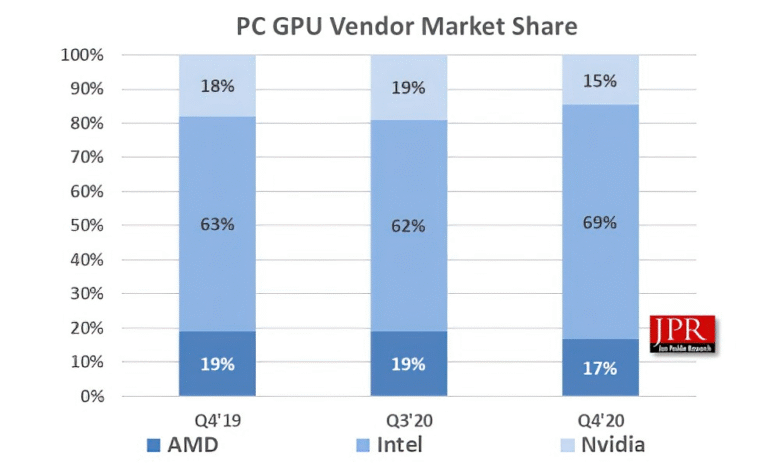Nvidia Market Share in China: Challenges and Forecasts

Nvidia’s market share in China is facing a significant downturn, with projections indicating a drop from 66% to 54% by 2025. Despite recent assurances that the company can resume sales of its H20 chips in this key market, competition from local chip manufacturers is intensifying, raising concerns about Nvidia’s future position in the AI chip market. The resurgence of Chinese firms such as Huawei and Cambricon has not only captured more customers but has also advanced rapidly in technology development during Nvidia’s supply restrictions. Analysts highlight that the increasing localization of China’s AI chip market, expected to rise dramatically in the coming years, may further challenge Nvidia’s dominance amid tightening regulations and geopolitical tensions. As AI solutions become more integrated into China’s technological landscape, Nvidia’s competition in China is set to grow more fierce, potentially reshaping the balance of power in this critical industry.
The landscape of the semiconductor industry in China is evolving, with Nvidia’s stronghold being tested as domestic manufacturers gain momentum. Known for its cutting-edge H20 chips, Nvidia is now vying for relevance within a rapidly changing AI chip ecosystem where local brands are making notable strides. With increasing restrictions on chip supplies from the U.S., the China chip manufacturers are stepping up to meet domestic demands, leading to a notable shift in the market dynamics. As competition escalates, Nvidia must navigate these challenges carefully to maintain its foothold while adapting to a landscape that is increasingly favoring local innovations. This environment poses critical questions about the future of international tech companies in China amid rising nationalistic policies and a push for self-sufficiency in the tech sector.
Nvidia Market Share in China: Current Challenges
Nvidia’s presence in the Chinese AI chip market is currently facing significant challenges. Changes in market dynamics and local regulations have led to a projected decline in Nvidia’s market share, which is anticipated to drop from 66% in 2024 to just 54% by 2025. These figures have been arrived at by Bernstein, a global equity research firm, highlighting how local Chinese chip manufacturers, bolstered by favorable governmental policies, are gaining traction among consumers. As companies like Huawei and Cambricon continue to innovate, the shift in market preference could make it increasingly difficult for Nvidia to reclaim its previous stronghold.
The decline in Nvidia’s market share is influenced not only by increasing competition from domestic firms but also by intricate regulatory challenges emerging from the Chinese government. During recent discussions, Nvidia was summoned by officials over national security issues, igniting concerns about the company’s long-term sustainability in China. With the localization ratio of AI chip production projected to rise from 17% to 55% in just a few years, the urgency for Nvidia to adapt its strategy becomes even more critical.
Nvidia H20 Chips: Re-Entry and Impact on Market Dynamics
The re-entry of Nvidia’s H20 chips into the Chinese market has sparked considerable attention, especially as the company received support from the Trump administration regarding export controls. Although this development might be seen as a silver lining for Nvidia, analysts suggest that the company will not necessarily regain its former market enthusiasm. The overall response from Chinese consumers could be tepid, primarily due to the heightened presence and advantage of local competitors who have been thriving in the chip market in Nvidia’s absence.
Furthermore, while the introduction of a “fully compliant” chip tailored for China is a strategic maneuver, it is essential to note that this might not suffice in overcoming the perception of advanced technology offered by indigenous manufacturers. The competitive edge that companies like Hygon have gained during the H20 export ban means that consumers may prefer these localized options over Nvidia’s offerings. As a result, Nvidia’s challenge will lie not only in re-establishing its market presence but also in effectively communicating the value and relevance of its products in a landscape that is quickly evolving.
The Competitive Landscape: Nvidia vs. Local Manufacturers
As Nvidia prepares to re-enter the Chinese market, it must contend with the increasing prowess of local AI chip manufacturers who have succeeded in capturing a significant portion of the market share. Companies like Huawei and Cambricon are rapidly innovating and developing competitive technologies that often resonate more closely with domestic consumers. This growing acceptance of Chinese brands presents a formidable challenge for Nvidia, which not only has to navigate its re-entry but also strategize on how to position itself against established local competitors.
Moreover, the growing focus on self-sufficiency within China’s technology sector means a stronger emphasis on domestic products. As local manufacturers continue to invest in research and development, their technologies are likely to match or even surpass those offered by foreign competitors in certain aspects. Therefore, Nvidia faces an uphill battle in not just regaining its market share in China, but also in ensuring that its technology is perceived as superior or at least on par with that of its local rivals.
Impact of Government Policies on Nvidia’s Recovery
The influence of government policy on Nvidia’s potential recovery in China cannot be overstated. The recent summons to Nvidia over national security concerns signals the cautious stance that the Chinese government is taking with respect to foreign technology. China has made significant efforts to promote domestic chip production as a means to bolster its technological sovereignty. This impacts Nvidia directly, as collaboration or integration with local firms may be required to navigate a complex regulatory landscape and regain market confidence.
Furthermore, even as export restrictions are eased, there remains a possibility that the geopolitical climate could shift again, affecting Nvidia’s ability to operate unhindered in the Chinese market. The desire of Chinese officials to further direct technological development toward homegrown companies means that Nvidia would need a carefully crafted strategy to position itself favorably within this evolving framework. To truly succeed, Nvidia must not only focus on its product offerings but also build relationships and adapt to local market expectations.
Future Outlook for Nvidia in the AI Chip Market
Looking forward, the outlook for Nvidia in China’s AI chip market appears to be a mixed bag. Analysts have suggested that while opportunities exist, the immediate future will likely be characterized by heightened competition and further market penetration by local companies. Nvidia’s efforts to introduce a compliant chip and resume H20 sales will be crucial steps, but they may not completely mitigate the challenges posed by homegrown alternatives. Adopting flexible strategies and reinforcing brand trust in the market may help bolster Nvidia’s recovery.
Additionally, Nvidia may have to rethink its value proposition to Chinese consumers who are increasingly inclined to favor localized options. This could entail not only showcasing innovative technology but also the added benefits of local partnerships and support networks. To enhance its competitive edge, Nvidia must invest in market research and consumer behavior analysis to better understand shifting preferences, thereby facilitating a tailored approach that resonates with the evolving demands of Chinese buyers.
Nvidia’s Response to Rising Competition in China
In response to the intense competition from Chinese companies, Nvidia has been working on several strategies to maintain its relevancy in the evolving chip landscape. One significant aspect of this response has been the development of partnerships with local firms and organizations, aiming to foster synergy and exchange between Nvidia’s technology and the nascent capabilities of its Chinese counterparts. This collaborative approach could help mitigate the perception challenge that Nvidia faces in the wake of local innovations.
Moreover, Nvidia is exploring investment opportunities within China that would allow it to enhance its research and development capabilities directly in the market. By embedding itself within China’s technological ecosystem, Nvidia can better align its offerings with local demands while also establishing a foothold for growth. However, this approach could be met with scrutiny, and Nvidia must be cautious to navigate the regulatory waters effectively, particularly as tensions surrounding national security concerns remain prevalent.
Technological Innovations and Market Strategy
A technology-centric approach is vital for Nvidia as it strives to reclaim its market foothold in China. The introduction of innovative products such as the more compliant H20 chip is step one; the next step involves anticipating and responding to emerging trends in consumer preferences. By aligning its R&D efforts with the needs of the local market, Nvidia can better position itself to meet demand while showcasing its commitment to technological advancement.
In addition, Nvidia must enhance its market strategies by effectively communicating its value propositions. This may include emphasizing superior technology and performance metrics while also addressing any potential consumer concerns over supply guarantees and support services that could arise from choosing a foreign brand over domestic options. Developing a clear, localized marketing strategy that resonates with Chinese consumers will be instrumental in building trust and loyalty.
The Role of AI in Nvidia’s Future in China
The burgeoning field of artificial intelligence presents both opportunities and challenges for Nvidia’s future in China. As AI continues to shape the tech landscape, Nvidia may find increased interest from Chinese companies looking to leverage cutting-edge technology for various applications. By positioning itself as a leader in AI chip technology and emphasizing the performance benefits of its products, Nvidia can cultivate a stronger presence in a market where AI is becoming integral to business operations.
Conversely, as the landscape of AI chip manufacturing evolves, Nvidia cannot overlook the competitive threat posed by domestic firms that are rapidly advancing their own AI capabilities. It is imperative for Nvidia to stay abreast of technological trends and innovations that emerge within China to ensure it maintains a competitive edge. Strategic collaborations with AI developers and educational institutions could also provide Nvidia with insights and opportunities, fostering an environment of innovation that reinforces its market position.
Strategic Collaborations: Key to Sustaining Market Presence
In an aggressive market like China, strategic collaborations have emerged as crucial for companies seeking to uphold their market presence. For Nvidia, fostering partnerships with local firms can serve as a significant advantage in navigating competitive and regulatory challenges. By aligning its objectives with those of domestic companies, Nvidia can create synergies that bolster both parties’ capabilities and market appeal, positioning itself effectively against local competitors.
Moreover, strategic alliances can streamline the process of addressing consumer needs, as local partners provide vital insights into market dynamics. These collaborations may also enhance Nvidia’s credibility among Chinese consumers who are inclined to support native brands. Pursuing joint ventures or co-development initiatives could not only facilitate access to innovation but may further instigate a culture of cooperation in a landscape traditionally dominated by competition.
Frequently Asked Questions
What is Nvidia’s current market share in the AI chip sector in China?
As of 2025, Nvidia’s market share in China’s AI chip sector is projected to decline to 54%, down from 66% the previous year, due to increased competition from local Chinese chip manufacturers.
How are China chip manufacturers affecting Nvidia’s market presence?
Chinese chip manufacturers, such as Huawei and Cambricon, have been rapidly advancing in the AI chip market, capturing more customers during Nvidia’s restriction period, which has contributed to Nvidia’s declining market share in China.
What challenges does Nvidia face in regaining its market share in China?
Nvidia faces multiple challenges in regaining its market share in China, including new competition from local companies, ongoing regulatory scrutiny from Beijing, and the necessity to rebuild customer trust after its H20 chips were blocked from the market.
Will Nvidia’s H20 chips help recover its market share in China?
Although Nvidia’s H20 chips are expected to return to the Chinese market, experts believe that the company may not recover its previous market share due to heightened competition and supply restrictions.
What is the projected localization ratio for China’s AI chip market?
The localization ratio of China’s AI chip market is expected to surge from 17% in 2023 to 55% by 2027, indicating a significant shift toward domestic chip production and further challenging Nvidia’s market position.
How are U.S. chip supply restrictions impacting Nvidia’s competition in China?
The U.S. chip supply restrictions have allowed Chinese companies to enhance their capabilities in AI chip development, therefore increasing competitive pressure on Nvidia and limiting its market share potential in China.
What role do national security concerns play in Nvidia’s market challenges in China?
National security concerns raised by Beijing regarding Nvidia’s operations are likely to complicate the company’s sales efforts and regulatory compliance, further impacting its potential market share recovery in China.
How might future U.S.-China trade negotiations impact Nvidia’s market strategy?
Future trade negotiations may result in a sliding scale for export restrictions, potentially granting U.S. chip manufacturers like Nvidia increased access to the Chinese market, but with the understanding that local AI infrastructure development will continue to receive government support.
Are there opportunities for Nvidia to improve its competitiveness in China?
While Nvidia faces significant challenges, opportunities such as the introduction of a new ‘fully compliant’ chip designed for China could improve its competitiveness, if supported by favorable market conditions and regulatory environments.
| Key Point | Details |
|---|---|
| Market Share Projection | Nvidia’s market share in China is expected to drop to 54% by 2025, down from 66% in 2024 according to Bernstein. |
| Competition | Local competitors like Huawei and Cambricon are gaining ground, disrupting Nvidia’s dominance in the AI chip sector. |
| Regulatory Concerns | Beijing’s scrutiny and national security summoning of Nvidia could complicate their market operations further. |
| H20 Chip Situation | While Nvidia is expected to re-enter the market with its H20 chips, analysts believe demand may not match previous levels due to competition. |
| Long-Term Outlook | The localization of China’s AI chip market is predicted to rise significantly, impacting the demand for imported chips. |
Summary
Nvidia’s market share in China is facing a significant decline amidst increasing competition and regulatory challenges. Despite the potential return of H20 chips to the Chinese market, Nvidia market share China is forecasted to drop as local manufacturers rise. The analysts predict that Chinese companies will continue to capture a growing portion of the market, making it difficult for Nvidia to reclaim its previous standing.




